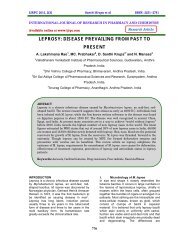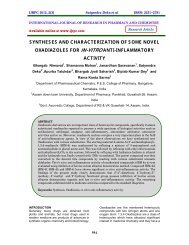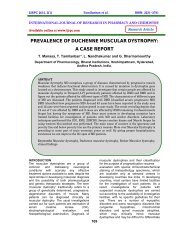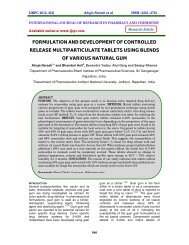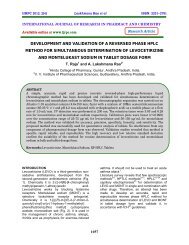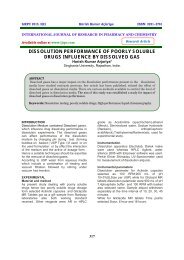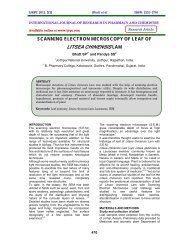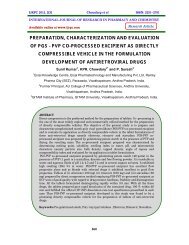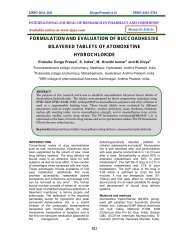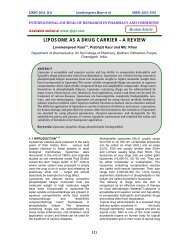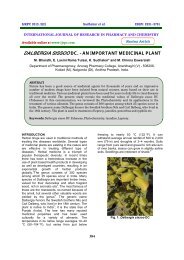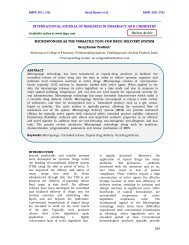A REVIEW ON HEPATOPROTECTIVE HERBAL DRUGS - ijrpc
A REVIEW ON HEPATOPROTECTIVE HERBAL DRUGS - ijrpc
A REVIEW ON HEPATOPROTECTIVE HERBAL DRUGS - ijrpc
Create successful ePaper yourself
Turn your PDF publications into a flip-book with our unique Google optimized e-Paper software.
IJRPC 2012, 2(1) Anil Kumar et al. ISSN: 22312781<br />
INTERNATI<strong>ON</strong>AL JOURNAL OF RESEARCH IN PHARMACY AND CHEMISTRY<br />
Available online at www.<strong>ijrpc</strong>.com<br />
Review Article<br />
A <strong>REVIEW</strong> <strong>ON</strong> <strong>HEPATOPROTECTIVE</strong> <strong>HERBAL</strong> <strong>DRUGS</strong><br />
٭Kumar Anil<br />
Department of Pharmacognosy, Pharmacy College, Itaura, Chandeshwar, Azamgarh,<br />
Uttar Pradesh, India.<br />
ABSTRACT<br />
Liver is a vital organ play a major role in metabolism and excretion of xenobiotics from the<br />
body. Liver cell injury caused by various toxic chemicals (certain anti-biotic, chemotherapeutic<br />
agents, carbon tetrachloride (CCl4), thioacetamide (TAA) etc.), excessive alcohol consumption<br />
and microbes is well-studied. The available synthetic drugs to treat liver disorders in this<br />
condition also cause further damage to the liver. Hence, Herbal drugs have become<br />
increasingly popular and their use is wide-spread. Herbal medicines have been used in the<br />
treatment of liver diseases for a long time so the maintenance of a healthy liver is essential for<br />
the overall well being of an individual. Liver injury induced by toxins is more common<br />
nowadays. Herbal remedies are focused in the pharmaceutical industry to evolve a safe route<br />
for liver disorders. Therefore, hepatoprotective natural products such as Andrographic<br />
paniculata, Chamomile capitula , Silybum marianum, Coccinia grandis, Flacourtia indica,<br />
Wedelia calendulacea, Annona squamosa, Prostechea michuacana, Ficus carica, Lepidium<br />
sativum, Sargassum polycystum, Solanum nigrum, swertia chirata, Phyllanthus emblica,<br />
Curcuma longa, Picrorhiza kurroa, Azadirachta indica, Aegle marmelos, Cassia roxburghii,<br />
Orthosiphon stamineus, Jatropha curcas, Foeniculum vulgare, Trigonella foenum graecum,<br />
Eclipta alba, Garcinia mangostana Linn is reviewed. The present review is aimed at compiling<br />
data on promising Phytochemical from medicinal plants that have been tested in<br />
hepatotoxicity models using modern scientific system.<br />
Keywords: hepatoprotection, hepatotoxicity, herbal drugs.<br />
INTRODUCTI<strong>ON</strong><br />
Liver is considered to be one of the most vital<br />
organs that functions as a centre of metabolism<br />
of nutrients such as carbohydrates, proteins,<br />
lipids and excretion of waste metabolites.<br />
Additionally, it is also handling the metabolism<br />
and excretion of drugs and other xenobiotics<br />
from the body thereby providing protection<br />
against foreign substances by detoxifying and<br />
eliminating them. The bile secreted by the liver<br />
has, among other things, plays an important role<br />
in digestion.<br />
Hepatic disease (Liver disease) is a term that<br />
affects the cells, tissues, structures, or functions<br />
of the liver. Liver has a wide range of functions,<br />
including detoxification, protein synthesis, and<br />
production of biochemical necessary for<br />
digestion and synthesis as well as breakdown of<br />
small and complex molecules, many of which<br />
are necessary for normal vital functions. Herbal<br />
drugs are more widely used than allopathic<br />
drugs as hepatoprotective because of them are<br />
inexpensive, better cultural acceptability, better<br />
compatibility, with the human body and minimal<br />
side effects. These herbal drugs have shown the<br />
ability to maintain the normal functional statues<br />
92
IJRPC 2012, 2(1) Anil Kumar et al. ISSN: 22312781<br />
of the liver with or without fewer side effects.<br />
The liver plays an astonishing array of vital<br />
functions in the maintenance, performance and<br />
regulating homeostasis of the body. It is involved<br />
with almost all the biochemical pathways to<br />
growth, fight against disease, nutrient supply,<br />
energy provision and reproduction. Therefore,<br />
maintenance of a healthy liver is essential for<br />
the overall well being of an individual. Liver cell<br />
injury caused by various toxicants such as<br />
certain chemotherapeutic agents, carbon<br />
tetrachloride, thioacetamide etc., chronic alcohol<br />
consumption and microbes is well-studied. Since<br />
The Indian Traditional Medicine like Ayurveda,<br />
Siddha and Unani are predominantly based on<br />
the use of plant materials. Herbal drugs have<br />
gained importance and popularity in recent<br />
years because of their safety, efficacy and cost<br />
effectiveness. Several Indian medicinal plants<br />
have been extensively used in the Indian<br />
traditional system of medicine for the<br />
management of liver disorder. The use of natural<br />
remedies for the treatment of liver diseases has<br />
a long history and medicinal plants and their<br />
derivatives are still used all over the world in one<br />
form or the other for this purpose. Scientific<br />
evaluation of plants has often shown that active<br />
principles in these are responsible for<br />
therapeutic success. A large number of<br />
medicinal plants have been tested and found to<br />
contain active principles with curative properties<br />
against a variety of diseases. Liver protective<br />
plants contain a variety of chemical constituents<br />
like phenols, Coumarins, Lignans, essential oil,<br />
monoterpenes, carotinoids, glycosides,<br />
flavonoids, organic acids, lipids, alkaloids and<br />
xanthenes. Therefore a large number of plants<br />
and formulations have been claimed to have<br />
hepatoprotective activity so the development of<br />
plant based hepato protective drugs has been<br />
given importance in the global market. This<br />
review article has been presented to enumerate<br />
some indigenous plants that have<br />
hepatoprotective properties such as<br />
Andrographic paniculata, Chamomile capitula ,<br />
Silybum marianum, Coccinia grandis, Flacourtia<br />
indica, Wedelia calendulacea, Annona<br />
squamosa, Prostechea michuacana, Ficus<br />
carica, Lepidium sativum, Sargassum<br />
polycystum, Solanum nigrum, swertia chirata,<br />
Phyllanthus emblica, Curcuma longa, Picrorhiza<br />
kurroa, Azadirachta indica, Aegle marmelos,<br />
Cassia roxburghii, Orthosiphon stamineus,<br />
Jatropha curcas, Foeniculum vulgare, Trigonella<br />
foenum graecum, Eclipta alba, Garcinia<br />
93<br />
mangostana Linn is reviewed.<br />
Eclipta alba<br />
Eclipta alba (Bhringaraja), belonging to family<br />
Composite is a perennial shrub which grows<br />
widely in moist tropical countries. It is used as<br />
alterative, anthelmintic, expectorant, antipyretic,<br />
antiasthmatic, tonic, deobstruent in hepatic and<br />
spleen enlargement and significant antiinflammatory<br />
activity. It has been reported to be<br />
useful in liver ailments & has been shown to<br />
possess hepatoprotective activity against<br />
carbon- tetrachloride induced liver cell damage<br />
in animals. The effect of Eclipta alba extract was<br />
studied on paracetamol induced hepatic damage<br />
in Mice. Treatment with ethanol extract of E.<br />
alba was found to protect the mice from hepatotoxic<br />
action of paracetamol as evidenced by<br />
significant reduction in the elevated serum<br />
transaminase levels.<br />
Foeniculum vulgare<br />
Fennel (Foeniculum vulgare Mill. family<br />
Umbelliferae) is an annual, biennial or perennial<br />
aromatic herb, depending on the variety, the<br />
leaves, stalks and seeds (fruits) of the plant are<br />
edible. Foeniculum vulgare is an aromatic herb<br />
whose fruits are oblong, ellipsoid or cylindrical,<br />
straight or slightly curved and greenish or<br />
yellowish brown in colour. Volatile components<br />
of fennel seed extracts by chromatographic<br />
analysis include trans-anethole, fenchone,<br />
methylchavicol, limonene, α-pinene, camphene,<br />
β-pinene, β-myrcene, α-phellandrene, 3-carene,<br />
camphor, and cis anethole. Hepatoprotective<br />
activity of Foeniculum vulgare essential oil was<br />
studied using a carbon tetrachloride-induced<br />
liver fibrosis model in rats. The hepatotoxicity<br />
produced by chronic carbon tetrachloride<br />
administration was found to be inhibited by<br />
Foeniculum vulgare essential oil with evidence<br />
of decreased levels of serum aspartate<br />
aminotransferase, alanine aminotransferase,<br />
alkaline phosphatase and bilirubin.<br />
Trigonella foenum graecum<br />
Fenugreek (Trigonella foenum graecum) is an<br />
annual herb that belongs to the family<br />
Leguminosae. The seeds of fenugreek are<br />
commonly used as a spice in food preparations<br />
due to the strong flavour and aroma. The seeds<br />
are reported to have restorative and nutritive<br />
properties. Fenugreek seeds have antioxidant<br />
activity and have been shown to produce<br />
beneficial effects such as neutralization of free
IJRPC 2012, 2(1) Anil Kumar et al. ISSN: 22312781<br />
radicals and enhancement of antioxidant<br />
apparatus. The protective effect of a<br />
polyphenolic extract of fenugreek seeds against<br />
ethanol-induced toxicity was investigated in<br />
human Chang liver cells. Ethanolic treatment<br />
suppressed the growth of Change liver cells and<br />
induced cytotoxicity, oxygen radical formation<br />
and mitochondrial dysfunction. Incubation of<br />
FPEt along with EtOH significantly increased<br />
cell viability in a dose-dependent manner,<br />
caused a reduction in lactate dehydrogenase<br />
leakage and normalized GSH/GSSG ratio. The<br />
findings suggest that the polyphenolic<br />
compounds of fenugreek seeds on the other<br />
gastric and lung cancer cell lines included in the<br />
screen. The investigators suggested that<br />
garcinone E may be potentially useful for the<br />
treatment of certain types of cancer.<br />
Garcinia mangostana Linn<br />
Garcinia mangostana Linn. commonly known as<br />
" mangos teen", is a tropical evergreen tree and<br />
is an emerging category of novel functional<br />
foods sometimes called "super fruits" presumed<br />
to have a combination of appealing subjective<br />
characteristics, such as taste, fragrance and<br />
visual qualities, nutrient richness, antioxidant<br />
strength and potential impact for lowering risk of<br />
human diseases . The pericarps of G.<br />
mangostana have been widely used as a<br />
traditional medicine for the treatment of diarrhea,<br />
skin infection and chronic wounds in South East<br />
Asia for many years. These are the nature’s<br />
most abundant sources of xanthones, which are<br />
the natural chemical substances possessing<br />
numerous bioactive properties that help to<br />
maintain intestinal health, neutralize free<br />
radicals, help and support joints and cartilage<br />
functions and promotes immune systems. These<br />
are extracted from the rind of mangos teen<br />
containing 95% xanthones also isoflavones,<br />
tannin and flavonoids. Treatment of<br />
hepatocellular carcinomas (liver cancer) with<br />
chemotherapy has generally been disappointing<br />
and it is most desirable to have more effective<br />
new drugs. The investigators extracted and<br />
purified 6 xanthone compounds from the rinds<br />
(peel) of the fruit of Garcinia mangostana,<br />
mangos teen fruit. The investigators tested this<br />
extract on 14 different human liver cancer cell<br />
lines. Several chemotherapeutic agents (drugs)<br />
were included in the study for comparison. The<br />
results showed that one of the xanthone<br />
derivatives which could be identified as<br />
garcinone E has potent cytotoxic effect (kill cells)<br />
94<br />
on all liver cancer cell lines as well as.<br />
Jatropha curcas<br />
Jatropha curcas Linn (Family: Euphorbiaceae),<br />
is an evergreen shrub, indigenous to America,<br />
but cultivated in most parts of India. This<br />
evergreen plant is common in waste places<br />
throughout India, especially on the Coromandel<br />
Coast and in Travancore; in the southern parts it<br />
is cultivated chiefly for hedges in the Konkan,<br />
and also in Malay Peninsula. Leaves are<br />
regarded as antiphrastic, applied to scabies;<br />
rubefacient for paralysis, rheumatism; also<br />
applied to hard tumours. Leaves also show<br />
antileukemic activity. Compounds that have<br />
been isolated from Jatropha curcas leaves<br />
include the flavonoids apigenin and its<br />
glycosides vitexin and isovitexin, the sterols<br />
stigmasterol, α -D-sitosterol and it’s α - D-<br />
glucoside. Methanolic fraction of leaves of<br />
Jatropha curcas (MFJC) was evaluated against<br />
hepatocellular carcinoma induced by Aflatoxin<br />
B1 (AFB1). Marked.<br />
Silybum marianum<br />
The protective effects of polyphenolic extracts of<br />
Sily-bum marianum and Cichorium intybus on<br />
thioacetamide- induced hepatotoxicity in rat was<br />
investigated (Madani et al., 2008). The extracts<br />
were injected to the rats, at a dose of 25 mg kg -1<br />
body weight together with thioacetamide at a<br />
dose of 50 mg kg body weight. Significant<br />
decrease in the activity of aminotransferase,<br />
alkaline phosphatase and bilirubin was observed<br />
in the groups treated with extracts and<br />
thioacetamide compared with the group that was<br />
treated only with thioacetamide. The level of<br />
Na + , K + and liver weight between different<br />
groups was not significantly altered. This finding<br />
suggested the hepatoprotective effect of<br />
Silybum marianum and Cichorium intybus<br />
extracts on liver cells due to the presence of<br />
flavonoids and their antioxidant effects (Madani<br />
et al., 2008).<br />
Chamomile capitula<br />
The effect of ethanolic extract of Chamomile<br />
recutita capitula (400 mg kg -1 , P.O.) on blood<br />
and liver glutathione, Na+ K+- ATPase activity,<br />
serum marker enzymes, serum bilirubin,<br />
glycogen and thiobarbutiric acid reactive<br />
substances against paracetamol-induced liver<br />
damage in rats have been studied to find out the<br />
possible mechanism of hepatoprotection. It was<br />
observed that extract of Chamomile recutita has
IJRPC 2012, 2(1) Anil Kumar et al. ISSN: 22312781<br />
reversal effects on the levels of abovementioned<br />
parameters in paracetamol<br />
hepatotoxicity (Gupta and Misra, 2006)<br />
suggesting its hepatoprotective and/or<br />
hepatostimulant activity.<br />
Coccinia grandis<br />
Alcoholic extract of the fruits of Coccinia grandis<br />
Linn (Curcubitaceae) was evaluated in CCl 4 -<br />
induced hepato-toxicity in rats and levels of<br />
AST, ALT, ALP, total proteins, total and direct<br />
bilirubin were evaluated. At a dose level of 250<br />
mg/kg, the alcoholic extract significantly (p
IJRPC 2012, 2(1) Anil Kumar et al. ISSN: 22312781<br />
were insignificant in the Lepidium sativum<br />
treated groups (Afaf et al., 2008).<br />
Sargassum polycystum<br />
The protective effect of ethanol extract of<br />
Sargassum polycystum was evaluated in D-<br />
galactosamine-induced hepatitis in rats. Prior<br />
oral administration of S. polycystum extract<br />
[125mg/kg bodyweight/day for 15 days]<br />
significantly attenuated (P
IJRPC 2012, 2(1) Anil Kumar et al. ISSN: 22312781<br />
(untreated) groups. Treatment with the<br />
methanolic extract of O. stamineus leaves (200<br />
mg/kg) has accelerated the return of the altered<br />
levels of biochemical markers to the near normal<br />
profile in the dose-dependent manner<br />
(Maheswari et al., 2008).<br />
Andrographis Paniculata<br />
Studies proved that Andrographis paniculata<br />
(Kalmegh) antihepatotoxic activity of the<br />
Andrographis paniculata (acanthaceae)<br />
methanolic extract (equivalent to 100 mg/kg of<br />
andrographolide) and 761.33 mg/kg ip, of the<br />
andrographolide-free methanolic extract<br />
(equivalent to 861.33 mg/kg of the methanolic<br />
extract) of the plant, using CCl 4 -intoxicated rats.<br />
Biochemical parameters like serum<br />
transaminase, SGOT and SGPT, serum alkaline<br />
phosphatase, serum bilirubin and hepatic<br />
triglycerides were estimated to assess the liver<br />
function. The results suggest that<br />
andrographolide is the major active<br />
antihepatotoxic principle present in A.<br />
paniculata. Other species of Andrographis i.e.<br />
Andrographis lineata nees had also proved<br />
hepatoprotective effect of Andrographis lineata<br />
(Acanthaceae) extracts in CCl 4 - induced liver<br />
injury in rats. Male Wistar rats with chronic liver<br />
damage, induced by subcutaneous injection of<br />
50% v/v CCl 4 in liquid paraffin at a dose of 3<br />
mL/kg on alternate days for a period of 4 weeks,<br />
were treated with methanol and aqueous<br />
extracts of A. lineata orally at a dose of 845<br />
mg/kg/day. The biochemical parameters such as<br />
serum glutamate oxaloacetate transaminase,<br />
serum glutamate pyruvate transaminase, serum<br />
bilirubin and alkaline phosphatase were<br />
estimated to assess the liver function.<br />
Histopathological examinations of liver tissue<br />
corroborated well with the biochemical changes.<br />
The activities of extracts were comparable to a<br />
standard drug. Andrographolide, the major<br />
antihepatotoxic component of the plant, exerted<br />
a pronounced protective effect in rats against<br />
hepatotoxicity induced by CCl4,<br />
Dgalactosamine, paracetamol and ethanol.<br />
Andrographolide inhibited the CCl4-induced<br />
increase in the activity of serum glutamate<br />
oxaloacetate transaminase, serum glutamate<br />
pyruvate transaminase, alkaline phosphatase,<br />
bilirubin and hepatic triglycerides. Oxidative<br />
damage through free radical generation involved<br />
in the hepatotoxic effect of carbon tetrachloride<br />
(CCl 4 ) and paracetamol (PC). An anti-oxidant<br />
property of Andrographolide is claimed to be one<br />
97<br />
of the mechanisms of hepatoprotective effect.<br />
Adjuvant to hepatoprotective action drug is<br />
commonly have Antibacterial, Anti-inflammatory,<br />
Immunostimulatory, Antidiarrhoeal, Anti-human<br />
immunodeficiency virus (HIV), Antipyretic,<br />
Antimalarial & Antivenom activity, and used in<br />
urinary infections.<br />
Swertia Chirata<br />
Due to effect of hepatotoxicant (like ethanol,<br />
drugs, chemicals and others) serum aspartate<br />
aminotransferase (ASAT), alanine<br />
aminotransferase (ALAT), and alkaline<br />
phosphatase (ALP) activities and bilirubin level<br />
are increased, but liver glycogen and serum<br />
cholesterol levels are decreased. Histologically it<br />
produced hepatocytic necrosis especially in the<br />
centrilobular region. Simultaneous treatments<br />
with Swertia chirata caused improvement at both<br />
biochemical and histopathological parameters.<br />
Drug also possesses digestive, hepatic<br />
(conditions pertaining to the liver), tonic,<br />
astringent and appetizer properties and used in<br />
cough, dropsy and skin diseases. Swertia<br />
Chirata (Chirayata) Simultaneous treatments<br />
with S. Chirata (Gentianceae). (in different<br />
doses, viz. 20, 50, and 100 mg/kg body wt daily)<br />
and (CCl4) caused improvement at both<br />
biochemical and histopathological parameters<br />
compared to that of (CCl4) treatment alone but it<br />
was most effective when S. chirata was<br />
administered in a moderate dose (50 mg/kg<br />
body wt).<br />
Phyllanthus amarus (Bhuiamala)<br />
Ethanolic extract of Phyllanthus amarus<br />
(Euphorbiaceae), at (0.3g kg (-1) BW 0.2 ml (-1)<br />
day (-1) was given to all groups except control<br />
groups (gp. I and gp. V), after 30 min of aflatoxin<br />
administration. The entire study was carried out<br />
for 3 months and animals were sacrificed after<br />
an interval of 30 days till the completion of study.<br />
Phyllanthus amarus extract was found to show<br />
hepatoprotective effect by lowering down the<br />
content of thiobarbituric acid reactive<br />
substances (TBARS) and enhancing the<br />
reduced glutathione level and the activities of<br />
antioxidant enzymes, glutathione peroxidase<br />
(GPx), glutathione-S transferase (GST),<br />
superoxide dismutase (SOD) and catalase<br />
(CAT).<br />
Morinda citrifolia L. (Noni)<br />
The hepatoprotective effects of Noni juice (TNJ)<br />
(Rubiaceae) against CCl4-induced chronic liver
IJRPC 2012, 2(1) Anil Kumar et al. ISSN: 22312781<br />
damage in female Sprague Dawley (SD) rats.<br />
Histopathological examination revealed that liver<br />
sections from the TNJ + CCl4 appeared similar<br />
to controls, whereas typical hepatic steatosis<br />
was observed in the placebo + CCl4 group.<br />
Serum alkaline phosphatase (ALP), aspartate<br />
aminotransferase (AST), alanine transaminase<br />
(ALT), total cholesterol (TC), triglycerides (TG),<br />
low-density lipoprotein (LDL), and very lowdensity<br />
lipoprotein (VLDL) levels were increased<br />
in the placebo group compared with the TNJ<br />
group. In contrast, high-density lipoprotein (HDL)<br />
was increased in the TNJ group and decreased<br />
in the placebo group. Thus, TNJ juice appears to<br />
protect the liver from chronic exogenous CCl4<br />
exposures.<br />
Fumaria indica (Hauskn)<br />
Fumaria indica (Fumariceae) were studied for<br />
their hepatoprotective activity against carbon<br />
tetrachloride, paracetamol and rifampicininduced<br />
heptatotoxicites in albino rats. The<br />
petroleum ether extract against<br />
carbonetrachloride, total aqueous extract<br />
against paracetamol and methanolic extract<br />
against rifampicin-induced hepatotoxicities<br />
showed similar reductions in the elevated levels<br />
of some of the serum biochemical parameters in<br />
a manner similar that of silymarin indicating its<br />
potential as a hepatoprotective agent.<br />
Cassia fistula (Amaltas)<br />
Hepatoprotective activity of the n-heptanes<br />
extract of Cassia fistula (Fabaceae) leaves was<br />
investigated by inducing hepatotoxicity with<br />
paracetamol in rats. The extract at a dose of 400<br />
mg/kg body wt. exhibited orally, significant<br />
protective effect by lowering the serum levels of<br />
transaminase (SGOT and SGPT), bilirubin and<br />
alkaline phosphatase (ALP). The effects<br />
produced were comparable to that of a standard<br />
hepatoprotective agent.<br />
Careya arborea<br />
The methanol extract of Careya arborea bark,<br />
(Myrtaceae) was tested for antioxidant and<br />
hepatoprotective activity in Ehrlich ascites<br />
carcinoma (EAC) tumor-bearing mice. Tumor<br />
control animals inoculated with EAC showed a<br />
significant alteration in the levels of antioxidant<br />
and hepatoprotective parameters. The extract<br />
treatment at 50, 100 and 200 mg/kg body weight<br />
doses given orally caused a significant reversal<br />
of these biochemical changes towards the<br />
normal in serum. Liver and kidney when<br />
98<br />
compared to tumor control animals indicating the<br />
potent antioxidant and hepatoprotective nature<br />
of the standardized extract.<br />
Azadirachta indica (Neem)<br />
Effect of A. indica leaf (Meliaceae) extract on<br />
serum enzyme levels (glutamate oxaloacetate<br />
transaminase, glutamate pyruvate<br />
transaminase, acid phosphatase and alkaline<br />
phosphatase) elevated by paracetamol in rats<br />
was studied with a view to observe any possible<br />
hepatoprotective effect of this plant. It is<br />
stipulated that the extract treated group was<br />
protected from hepatic cell damage caused by<br />
paracetamol induction. The findings were further<br />
confirmed by histopathological study of liver.<br />
The antihepatotoxic action of picroliv seems<br />
likely due to an alteration in the<br />
biotransformation of the toxic substances<br />
resulting in decreased formation of reactive<br />
metabolites.<br />
Picrorhiza kurroa (Kutki)<br />
Administration of picroliv, a standardized fraction<br />
of alcoholic extent of Picrorhiza kurroa<br />
(Scrophulariaceae) (3-12 mg/kg/day for two<br />
weeks) simultaneously with P. berghei infection<br />
showed significant protection against hepatic<br />
damage in Mastomys natalensis. The increased<br />
levels of serum glutamate oxaloacetate<br />
transaminase (GOT), glutamate pyruvate<br />
transaminase (GPT), alkaline phosphatase,<br />
lipoprotein-X (LP-X) and bilirubin in the infected<br />
animals were marked reduced by different doses<br />
of picroliv. In the liver, picroliv decreased the<br />
levels of lipid peroxides and hydroperoxides and<br />
facilitated the recovery of superoxide dismutase<br />
and glycogen.<br />
Phyllanthus emblica<br />
Ethanol extract of Phyllanthus emblica Linn.<br />
(Euphorbiaceous) (PE) induced rat hepatic<br />
injury. PE (0.5 and 1 mg/ml) increased cell<br />
viability of rat primary cultured hepatocytes<br />
being treated with ethanol (96 µl/m) by<br />
increasing % MTT and decreasing the release of<br />
transaminase. Pretreatment of rats with PE at<br />
oral dose of 25, 50 and 75 mg/kg or SL<br />
(silymarin, a reference hepatoprotective agent)<br />
at 5 mg/kg, 4 h before ethanol lowered the<br />
ethanol induced levels of AST, ALT and IL-<br />
1beta. The 75 mg/kg PE dose gave the best<br />
result similar to SL. Treatment of rats with PE<br />
(75 mg/kg/day) or SL (5 mg/kg/day) for 7 days<br />
after 21 days with ethanol (4 g/kg/day, p.o.)
IJRPC 2012, 2(1) Anil Kumar et al. ISSN: 22312781<br />
enhanced liver cell recovery by bringing the<br />
levels of AST, ALT, IL-1beta back to normal.<br />
Curcuma longa<br />
Curcuma longa or turmeric is a member of<br />
Zingiberaceae family which is a perennial herb<br />
with short and thick rhizomes. Turmeric has<br />
been used extensively in traditional Chinese<br />
medicine and Ayurvedic medical system .<br />
Curcuma longa contains approximately 2%<br />
volatile oil, composed mainly of a- and b-<br />
turmerone, monoterpenes (Leung and Foster<br />
1996), 5% curcuminoids, mainly curcumin 12 ,<br />
minerals, carotene and vitamin C 11 . The active<br />
constituent of Curcuma longa is Curcumin,<br />
which is the yellow pigment of turmeric. The<br />
hepatoprotective activity of the ethanol extract of<br />
Curcuma longa was investigated against<br />
paracetamol-induced liver damage in rats. At the<br />
dose of 600 mg/kg, paracetamol induced liver<br />
damage in rats as manifested by statistically<br />
significant increase in serum alanine<br />
aminotransferase (ALT) and Aspartate<br />
aminotransferase (AST) and alkaline<br />
phosphatase (ALP). Pretreatment of rats with<br />
the ethanolic extract of Curcuma longa (100<br />
mg/kg) prior to paracetamol dosing at 600 mg/kg<br />
statistically lowered the three serum liver<br />
enzyme activities. Moreover, treatment of rats<br />
with only the ethanolic extract of Curcuma longa<br />
(100 mg/kg) had no effects on the liver<br />
enzymes. This current result suggests that<br />
ethanolic extract of Curcuma longa has potent<br />
hepatoprotective effect against paracetamolinduced<br />
liver damage in rats.<br />
REFERENCES<br />
1. Agarwal SS. Development of<br />
hepatoprotective formulations from plant<br />
sources, Pharmacology and<br />
Therapeutics in the New Millennium,<br />
New Delhi, 2001:357-358.3.<br />
2. Arulkumaran KS, Rajasekaran A,<br />
Ramasamy A, Jegadee-san M,<br />
Kavimani S and Somasundaram A.<br />
Cassia rox-burghii seeds protect liver<br />
against toxic effects of ethanol and<br />
carbontetrachloride in rats. Int J Pharm-<br />
Tech Res. 2009;1(2):273-246.<br />
3. Achuthan CR, Babu BH and Padikkala<br />
J. Antioxidant and Hepatoprotective<br />
effects of Rosa damascene,<br />
Pharmaceut Biol. 2003;41:357-361.<br />
4. Aniya Y, Miyagi A, Nakandakari, Kamiya<br />
N, Imaizumi N and Ichiba T. Free radical<br />
99<br />
scavenging action of the medicinal herb<br />
Limonium wrightii from the Okinawa<br />
islands. Phytomedicine. 2002;9:239-<br />
244.<br />
5. Ansari RA, Tripathi SC, Patnaik GK and<br />
Dhawan BN. Antihepatotoxic properties<br />
of picroliv: an active fraction from<br />
rhizomes of Picrorhiza kurrooa. J<br />
Ethnopharmacol. 1991;34(1):61-8.<br />
6. Ajay KG and Neelam M.<br />
Hepatoprotective activity of aqueous<br />
and ethanolic extract of Chamomile<br />
capitula in paracetamol-intoxicated<br />
albino rats. American J Pharmacol<br />
Toxicol. 2006;1(1):17-20.<br />
7. Bardhan P, Sharma SK and Garg NK. In<br />
vitro effect of an ayurvedic liver remedy<br />
on hepatic enzymes in carbon<br />
tetrachloride treated rats. Indian Journal<br />
of Medical Research. 1985;82:359-364.<br />
8. Budavari S, The Merck Index: An<br />
Encyclopedia of Chemicals, Drugs and<br />
Biological, 12 th Edition, New York Merck<br />
& Co. Inc., Whitehouse Station,<br />
1996:1674.<br />
9. Chaterjee TK. Medicinal Plants with<br />
Hepatoprotective Properties, Herbal<br />
Options, Books & Allied (P) Ltd.,<br />
Calcutta, 2000:155.<br />
10. Chander R, Dwivedi Y, Rastogi R,<br />
Sharma SK, Garg NK, Kapoor NK and<br />
Dhawan BN Evaluation of<br />
hepatoprotective activity of picroliv from<br />
Picrorhiza kurroa in Mastomys<br />
natalensis infected with Plasmodium<br />
berghei. Int J Medicinal Res.<br />
1990;92:34-7.<br />
11. Chattopadhyay RR, Sarkar SK, Ganguly<br />
S, Banerjee RN, Basu TK and<br />
Mukherjee A. Hepatoprotective activity<br />
of Azadirachta indica leaves on<br />
paracetamol induced hepatic damage in<br />
rats. Indian J Exp Biol. 1992;30(8):738-<br />
40.<br />
12. Chandra T, Sadique J and Soma<br />
Sundram S. Effect of Eclipta alba on<br />
inflammation and liver injury. Fitoterapia.<br />
1987;58(1):23-32.<br />
13. Chopra RN, Nayar SL and Chopra IC.<br />
In: Glossary of medicinal plants, SIR<br />
Publication, New Delhi, 1966:104.<br />
14. Chang-Chi H, Hsun-Lang F and Wen-<br />
Chuan L. Inhibitory effect of Solanum<br />
nigrum on thioacetamide-induced liver
IJRPC 2012, 2(1) Anil Kumar et al. ISSN: 22312781<br />
fibrosis in mice. J Ethnopharmacol.<br />
2008;119:117–121.<br />
15. Fenugreek (Trigonella foenum graecum)<br />
seed extract prevents ethanol-induced<br />
toxicity and apoptosis in chang liver<br />
cells Subramanian Kaviarasan, Nalini<br />
Ramamurty, Palani Gunasekaran,<br />
Elango Varalakshmi and Carani<br />
Venkatraman Anuradha. Alcohol &<br />
Alcoholism. 2006;41(3):267–273.<br />
16. Gupta AK, Chitme H, Dass SK and<br />
Misra N. Antioxidant activity of<br />
Chamomile recutita capitula methanolic<br />
extracts against CCl4-induced liver<br />
injury in rats Journal of Pharmacology<br />
and Toxicology. 2006;1(b):101- 107.<br />
17. Handa SS and Sharma A.<br />
Hepatoprotective activity of<br />
andrographolide from Andrographis<br />
paniculata against carbontetrachloride.<br />
Indian J Med Res. 1990;92:276-83.<br />
18. Handa SS, Sharma A and Chakraborti<br />
KK. Natural products and plants as liver<br />
protecting drugs. Fitoterapia.<br />
1986;57(5):307-352.<br />
19. Hui-Mei L, Hsien-Chun T, Chau-Jong W,<br />
Jin-Jin L, Chia- Wen L and Fen-Pi C.<br />
Hepatoprotective effects of Solanum<br />
nigrum Linn extract against CCl4-iduced<br />
oxidative damage in rats, Chemico<br />
Biological Interactions. 2008;171:283–<br />
293.<br />
20. Hanefi Özbek, Serdar Ugras, Irfan<br />
Bayram, Ismail Uygan, Ender Erdogan,<br />
Abdurrahman Öztürk and Zübeyir<br />
Huyut. Hepatoprotective effect of<br />
Foeniculum vulgare essential oil: A<br />
carbon-tetrachloride induced liver<br />
fibrosis model in rats. J Lab Anim Sci.<br />
2004;1:3.<br />
21. Hepatoprotective effect of Foeniculum<br />
vulgare essential oil: A carbontetrachloride<br />
induced liver fibrosis model<br />
in rats. by Hanefi Özbek, Serdar Ugras,<br />
Irfan Bayram, Ismail Uygan, Ender<br />
Erdogan, Abdurrahman Öztürk1,<br />
Zübeyir Huyut1.Scand. J Lab Anim Sci.<br />
2004;3(1).<br />
22. Sultana S, Perwaiz S, Iqbal M and Athar<br />
M. Crude extracts of hepatoprotective<br />
plants, Solanum nigrum and Ci-chorium<br />
intybus inhibit free radical-mediated<br />
DNA damage. J Ethnopharmacol.<br />
1995;45:189-192.<br />
100<br />
23. Somchit MN, Sulaiman MR, Noratunlina<br />
R and Ahmad Z. Hepatoprotective<br />
effects of Curcuma longa rhizomes in<br />
paracetamol-induced liver damage in<br />
rats, Proceedings of the Regional<br />
Symposium on Environment and Natural<br />
Resources. 2002;1:698-702.<br />
24. Simándi B, Deák A, Rónyani E,<br />
Yanxiang G, Veress T, Lemberkovics È,<br />
Then M, Sass-Kiss Á and Vámos- Falusi<br />
Z. Supercritical carbon dioxide<br />
extraction and fractionation of Fennel<br />
oil. J Agric Food Chem. 1999;47:1635-<br />
40.<br />
25. Stickel F and Schuppan D. Herbal<br />
medicine in the treatment of liver<br />
diseases. Digestive and Liver Disease.<br />
2007;39:293–304.<br />
26. Saxena S, Sharma R, Rajore S and<br />
Batra A. Isolation and identification of<br />
flavonoid .Vitexin. from Jatropha curcas<br />
L. Jour Pl Sci Res. 2005;21:116.<br />
27. Saleem MTS, Christina AJM,<br />
Chidambaranathan N, Ravi V and<br />
Gauthaman K. Hepatoprotective activity<br />
of Annona squamosa (Linn) on<br />
experimental animal model. Int J<br />
Applied Res Nat Pro. 2008;1(3):1-7.<br />
28. Stickel F and Schuppan D. Herbal<br />
medicine in the treatment of liver<br />
diseases. Digestive and Liver Disease.<br />
2007;39:293–304.<br />
29. Özcan M, Akgül A, Baser KHC, Özok T<br />
and Tabanca N. Essential oil<br />
composition of sea fennel (Crithmum<br />
maritimum) from Turkey, Nahrung/Food.<br />
2001;45(5):353-6.<br />
30. Pramyothin P, Samosorn P,<br />
Poungshompoo S and Chaichantipyuth<br />
C. The protective effects of Phyllanthus<br />
emblica Linn. Extract on ethanol<br />
induced rat hepatic injury. J<br />
Ethnopharmacol. 2006;107(3):361-64.<br />
31. Primchanien Moongkarndi, Nuttavut<br />
Kosema, Sineenart Kaslungka, Omboon<br />
Luanratana, Narongchai Pongpan and<br />
Neelobol Neungton. Antiproliferation,<br />
anti oxidation and induction of apoptosis<br />
by Garcinia mangostana (mangosteen)<br />
on SKBR3 human breast cancer cell<br />
line. Journal of Ethanopharmacology.<br />
2004;90:161–166.<br />
32. Karan M, Vasisht K and Handa SS.<br />
Antihepatotoxic activity of Swertia<br />
chirata on paracetamol and
IJRPC 2012, 2(1) Anil Kumar et al. ISSN: 22312781<br />
galactosamine induced hepatotoxicity in<br />
rats. Phytotherapy Research.<br />
1999;13(2):95-101.<br />
33. Khosla P, Gupta DD and Nagpal RK.<br />
Effect of Trigonella foenum graecum<br />
(Fenugreek) on serum lipids in normal<br />
and diabetic rats. International Journal<br />
of Pharmacology. 1995;27:89–93.<br />
34. Kokate CK, Purohit AP and Gokhale SB.<br />
Pharmacognosy. 37th ed. Nirali<br />
Prakashan, 2006:232, 233, 248, 249,<br />
251.<br />
35. Kapoor LD, CRC Handbook of<br />
Ayurvedic Medicinal Plants, Boca<br />
Raton, CRC Press, 1990:149-150.<br />
36. Karandikar SM, Joglekar GV, Chitale<br />
GK and Balwani JH. Protection by<br />
indigenous drugs against hepatotoxic<br />
effect of carbon tetrachloride, a long<br />
term study, Ac-ta Pharmacologia et<br />
Toxicologia<br />
(Copenhagen),<br />
1963;20:274.<br />
37. Khin MaMa, Nyunt Nyunt and Maung<br />
tin. The protective effects of Eclipta alba<br />
on carbon tetrachloride Induced Acute<br />
Liver Damage. Toxicol And Applied<br />
Pharmacol. 1978;45:723-728.<br />
38. Mukherjee S, Sur A and Maiti BR.<br />
Hepatoprotective effect of Swertia<br />
chirata on rat. Indian J Exp Biol.<br />
1997;35(4):384-8.<br />
39. Marina Nazneen, Md. Abdul Mazid,<br />
Joydev K Kundu, Sitesh C Bachar,<br />
Farida Begum and Bidyut K Datta.<br />
Protective effects of Flacourtia indica<br />
aerial parts extracts against<br />
paracetamol‐induced hepatotoxicity in<br />
rats. Journal of taibah university for<br />
science. 2009;2:1-6.<br />
40. Murugaian P, Ramamurthy V and<br />
Karmegam N. Hepatoprotective activity<br />
of Wedelia calendulacea L. against<br />
acute hepatotoxicity in rats. Res J Agri &<br />
Biol Sci. 2008;4(6):685-687.<br />
41. Maheswari C, Maryammal R and<br />
Venkatanarayanan R. Hepatoprotective<br />
activity of “Orthosiphon stami-neus” on<br />
lver damage caused by paracetamol in<br />
rats. Jordan J Biological Sciences.<br />
2008;1(3):105-108.<br />
42. Meena B, Ezhilan RA, Rajesh R,<br />
Hussain KS, Ganesan B and Anandan<br />
R. Antihepatotoxic potential of<br />
Sargassum polycystum (Phaeophyceae)<br />
on antioxidant defense status in D-<br />
101<br />
galactosamine-induced hepatitis in rats.<br />
African J Biochem Res. 2008;2(2):051-<br />
055.<br />
43. Mehra PN and Nanda SS.<br />
Pharmacognosy of Bhringaraja.<br />
Antihepatotoxic drug of Indian origin. Ind<br />
J Pharm. 1968;30:284.<br />
44. Madani H, Talebolhosseini M, Asgary S<br />
and Nader GH. Hepatoprotective activity<br />
of Silybum marianum and Ci-chorium<br />
intybus against thioacetamide in rat. Pak<br />
J Nutrition. 2008;7(1):172-176.<br />
45. Niranjan A. Indian Journal of Natural<br />
Products and Resources.<br />
2010;1(2):125-135.<br />
46. Nahid Tabassum and Shyam. S.<br />
Agarwal. Hepatoprotective activity of<br />
Eclipta alba hassk. against paracetamol<br />
induced hepatocellular damage in mice.<br />
Experimental medicine. 2004;11(4).<br />
47. José Pedraza-Chaverri, Noemi<br />
Cárdenas-Rodríguez, Marisol Orozco-<br />
Ibarra and Jazmin M. Perez-Rojas.<br />
Medicinal properties of mangos teen<br />
(Garcinia mangostana). Journal of food<br />
and toxicology Elsevier. 2004;3:24-27.<br />
48. Raj DS, Vennila JJ and Aiyavu C.<br />
Panneerselvam K. The hepatoprotective<br />
effect of alcoholic extract of Annona<br />
squamosa leaves on experimentally<br />
induced liver in-jury in Swiss albino<br />
mice. Int J Int Bio. 2009;5(3):162-166.<br />
49. Rosa MP and Gutiérrez, Rosario VS.<br />
Hepatoprotective and inhibition of<br />
oxidative stress of Prostechea michuacana.<br />
Rec Nat Prod. 2009;3(1):46-51.<br />
50. Tripathi KD. Essential of Medical<br />
Pharmacology. 6th ed. Jaypee brother’s<br />
medical publishers, 2008.<br />
51. Thyagarajan SP, Jayaram S,<br />
Gopalakrishnan V, Hari R, Jeyakumar P<br />
and Sripathi MS. Herbal medicines for<br />
liver diseases in India. J Gastroenterol<br />
Hepatol. 2002;17(3):370-6.<br />
52. Vadivu R, Krithika A, Biplab C,<br />
Dedeepya P, Shoeb N and Lakshmi KS.<br />
Evaluation of hepatoprotective activity of<br />
the fruits of Coccinia grandis Linn. Int J<br />
Health Res. 2008;1(3):163-168.<br />
53. Vinodhini S, Malairajan S and Hazeena<br />
B. The hepatopro-tective effect of Bael<br />
Leaves (Aegle Marmelos) in al-coholinduced<br />
liver injury in albino rats. Int J<br />
Sci & Tech. 2007;2(2):83 92.
IJRPC 2012, 2(1) Anil Kumar et al. ISSN: 22312781<br />
54. Vinodhini singanan, Malairajan singanan<br />
and Hazeena begum. Hepatoprotective<br />
effect of bael leaves (aegle marmelos)in<br />
alcohol induced liver injury in albino rats,<br />
international journal of science &<br />
technology. 2007;2:83-92.<br />
55. WHO monographs on selected<br />
medicinal plants; volume- II; WHO<br />
Geneva; AITBS publishers, India; p12-<br />
21, 300-310.<br />
56. Warrier PK, Nambiar VPK and<br />
Ramankutty C, Foeniculum vulgare,<br />
Indian Medical Plants,3, 5, Chennai,<br />
1996:492.<br />
102



